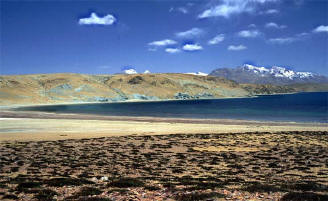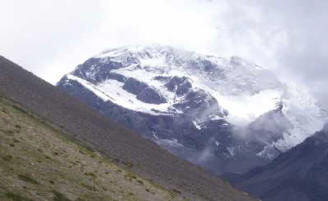Holy Destinations of India
Kailash Mansarovar Yatra
Mt. Kailash is claimed to be the apex of the Hindu religious axis, is also one of the highest mountains in Tibet at 22,022 feet. Lord Shiva resides over here among the peaceful Himalayas. A mythological story says that Lord Shiva once built a house for himself but gave it away to a devotee who asked for it. Thus without changing his residence he settled in the mountain of Kailash. This is his abode where he stays with his whole family including his wife Goddess Parvati and children Lord Ganesha and Lord Kartikiya and the other Shiv Ganas (group of Shiva Devotees) like Nandi and others. According to ancient religious texts, the abode of Lord Vishnu is called Vaikuntha, the abode of Lord Bhrama is called Bhramaloka and the abode of Lord Shiva is called Kailash. Of the three, one can only go bodily and return in this life from Kailash having experienced divinity. The Hindus, Bons and Jains all alike travel to this place as pilgrims. A journey to Kailash is considered as once in a lifetime achievement.
|
Photos of Mansarovar |
|
 |
 |
Legends, Myths & Beliefs
It is because of Kailash - Mansarovar, which is 865-kms from Delhi, that
Kumaon is sometimes called "Manaskhand". Many myths are associated with this
unusual mountain and lake. The Buddhists, the Jains and the Bonpas of Tibet
too, all revere this spot with great fervour and devotion. Therefore, it is
not surprising for a devotee to come across the worlds "Om Mani Padme Hum"
("Hail to the jewel (of Creation) in the Lotus) written on stones and taken
from Buddhist scriptures. The Bonpas make an anti-clockwise pilgrimage
around Mt. Kailash whereas the believers of the jain faith specially visit
astpaad near the southern face of Kailash in the Kailash --mansarovar
region.
Among the thousands of deities of Hinduism, Lord Shiva is the most beloved and the most sort after lord. Lord Shiva finds a great place in the heart of all devotees be it the Human beings, the Devataas or the Rakshasaas. He is even called Bhola Baba because of his uniqueness of being simple and he grants whatever the devotee asks for. This is the reason why he is having a large following in all the 3 worlds of Akash, Bhumi, & Patal. Bhola Baba filled with Vairagya (dispassion) is a joy of all spiritual seekers.
Kailash Mansarovar Yatra
Divinity is initiated in "Kailash Manasarovar Yatra" with arrival in
Katmandu - the capital city of Nepal, where deities mingle with the mankind.
A visit to the most dominant temple 'Pashupatinath' with many others equally
significant temples are of great merit. This primordial temple enshrines
faith of millions of Hindus throughout the world as Lord Shiva's sacred
residence. A spiritual atmosphere is maintained throughout the trip.
A briefing with experts on the second day, will prepare you for the ultimate
journey to the most sacred of all pilgrimages, the Kailash - Manasarovar.
Rest of the evening is for the preparation and inspection of the equipments
that are needed for the journey. The next day is the departure from the
hotel, you cross the Nepal- border and arrive in the Tibetan town called "Nyalam"
(3750m). Yatries overcome their exhaustion from 7 hrs drive and abrupt
altitude gain with the hospitality of our experienced staffs - which will
take care of your needs. Next day will be pretty normal - no movement, so
that you can rest and acclimatize with the altitude and extreme weather
conditions. For emergency, our crew will carry oxygen, PAC (Portable
Altitude Chamber) and other alternative as a measure to ensure your safety.
After attending at the altitude, you will start to feel better and enjoy more of journey towards the Holy Kailash. The day from Paryang makes everyone impatient, as this is a long awaited day of first 'Darshan' of Sacred Kailash and Manasarovar. Next two days are for Parikrama of Manasarovar. Then you are ready for the Kailash Parikarama. Yaks and helpers could be provided for the Parikrama. The yatris face glow with happiness that they have now covered the journey they only dreamt about. You can carry back sacred memories in form of stones, pebbles and water from the Manasarovar lake to your less fortune friends and relatives.
Significence of the Yatra
For Hindus, Mount Kailash is the earthly manifestation of Mt. Meru, the
spiritual centre of the universe around which all else revolves. With its
roots in the lowest hell and its summit kissing the heavens, where on top
live Lord Shiva and Parvati.
Jains call the mountain
Astapada and believe it to be the site where Rishaba, their first
Tirthankara (spiritual leader) achieved enlightenment. For Tibetans, Mt.
Kailash is known as Kang Rimpoche (Precious Jewel of Snow) and is seen as
the navel of the world and the abode of Chakrasamvara. Followers of the
older, more ancient religion of Bon believe the mountain is the where their
founder Shenrab is said to have descended from heaven.
Tips for Kailash Mansarovar Yatra
While trekking, walk towards the hill, not to the drop-side. Don't withdraw
towards drop-side to give way to any person or horse/pony.
The yatra time is from morning to noon. So you are advised to start early
and reach next camp by noon. Wet clothes, due to rain or sweat, should be
changed and make your arrangements for next day's yatra.
The arrangements for horses and porters are to be done in the very beginning
at Tawaghat. It is not possible to get them in the middle of yatra.
Trek according to the route. Don't experiment with shortcuts or untrodden
ways.
During your trek, be cautious, yet confident. Take special care of difficult
terrain and watch out for landslides, falling rocks/ boulders, cloudbursts,
the Kali River flowing alongside. You should trek as a team, taking care of
your other team-members and warning each other of potential hazards.
Use only water of safe springs for drinking. Fill your water bottles from
camp. On the wayside, teashops give relief.
During the selection itself Yatris are advised to procure good quality
trekking shoes/ walking-stick, raincoats, Polythene and Rucksacks to carry
their belongings, goggles, woolens mufflers, hats, jackets/wind-cheaters,
couple of pairs of socks, cameras, transistor radios and general medicines.
Notebooks and pens can also prove handy.
The weight of your luggage should be upto 25 kg only. Extra weight will be
charged.
From Delhi to Lipulekh and back from Lipulekh to Delhi there are good
arrangements by KMSV.N, but K.M.V.N. or Uttarakhand Tourism is not
responsible for any accident. If a yatri doesn't attend after selection,
money will be not refunded.
The lodging facilities on the way are in snow-huts, tin-sheds or tents in
some places. Warm beddings are adequately provided. All these facilities are
arranged in Tibet also. The yatries have to cock their own food for 6 days
while undertaking the 'parikrama'.
Onion-less food rice, dal, chapatis, vegetables, pickle, puri, paratha,
pakori, vegetable soup, sweets, rasna, tea, Bournvita, and local green
vegetables are available. The food required for the duration of the
parikrama is advised to be purchased from Delhi or any major town enroute.
In Tibet, stoves and utensils are provided.
In case of illness, one may have to stop the yatra midway and return, but
money is not refunded. In emergencies, a helicopter can also be arranged, on
payment and depending on availability.
Rucksack, water bottle, jacket or sleeping bags can be hired from KMVN.
Photography is not prohibited in India and Tibet so a sufficient stock of
reels is advisable. Exposed films can be deposited at Kalapani or at
Lipulekh.
For any information or suggestions please write to
General Manager (Tourism)
K.M.V.N. Ltd
Oak Park House
Nainital - 263001
Ph - 05942-36356
Fax - 05942-46897
or mail to
kmvn@yahoo.com
How to reach
There are 4 ways to reach Mount Kailash from India.
1) By road from India. The Government of India organises tours to Lake
Manasarovar. This is a 28-30 day trek but the disadvantage is that it has to
be booked well in advance and there is no certainty that one can go despite
being in physical shape, because the number of seats is limited and
participants are chosen by a draw by MInistry of External Affairs, India.
About 400 people make it from the 6000 that apply each year.
2) By air to Kathmandu and from there by road to Lake
Manasarovar at the base of Mount Kailash. One may fly to Kathmandu from
Delhi, Varanasi, Kolkata & Mumbai. Banglore flight is suspended as of now.
This has become the most popular route.
3) Helicopter tours of Kailash for those who are short of time or cannot
take the rigours of a grueling high altitude road journey. The tour uses
fixed wing aircraft for the flight from Kathmandu to Nepalganj and from
there to Simikot. From Simikot a helicopter flies to Hilsa. Landcruisers are
then used to reach Manasarovar.
4) Tour via Lhasa wherein one will fly to Kathmandu and then to Lhasa by China Air and from there one will visit various towns in Tibet like Shigatse, Gyantse, Lhatse, Prayang etc. and will reach Mansarovar. On the way back, there are three options a) drive back to Lhasa and fly back to Kathmandu b) drive to Hilsa and fly via Helicopter and fixed wing aircraft to Kathmandu c) Drive back to Kathmandu via Kodari Border (Friendship Bridge).